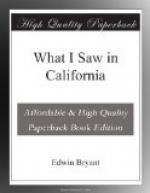Poor as our hostess was, she nevertheless was reluctant to receive any compensation for her hospitality. We, however, insisted upon her receiving a dollar from each of us (dos pesos), which she finally accepted; and after shaking us cordially by the hand she bade us an affectionate adios, and we proceeded on our journey.
From the Mission of San Jose to the Pueblo of San Jose, the distance is fifteen miles, for the most part over a level and highly fertile plain, producing a variety of indigenous grasses, among which I noticed several species of clover and mustard, large tracts of which we rode through, the stalks varying from six to ten feet in height. The plain is watered by several arroyos, skirted with timber, generally the evergreen oak.
We met this morning a Californian carreta, or travelling-cart, freighted with women and children, bound on a pleasure excursion. The carreta is the rudest specimen of the wheeled vehicle I have seen. The wheels are transverse sections of a log, and are usually about 2-1/2 feet in diameter, and varying in thickness from the centre to the rim. These wheels are coupled together by an axletree, into which a tongue is inserted. On the axletree and tongue rests a frame, constructed of square pieces of timber, six or eight feet in length, and four or five in breadth, into which are inserted a number of stakes about, four feet in length. This frame-work being covered and floored with raw hides, the carriage is complete. The carreta which we met was drawn by two yokes of oxen, driven by an Indian vaquero, mounted on a horse. In the rear were two caballeros, riding fine spirited horses, with gaudy trappings. They were dressed in steeple-crowned glazed sombreros, serapes of fiery colours, velvet (cotton) calzoneros, white cambric calzoncillos, and leggins and shoes of undressed leather. Their spurs were of immense size.
The party halted as soon as we met them, the men touching their heavy sombreros, and uttering the usual salutation of the morning, “Buenos dios, senores,” and shaking hands with us very cordially. The same salutation was repeated by all the senoras and senoritas in the carreta. In dress and personal appearance the women of this party were much inferior to the men. Their skins were dark, sallow, and shrivelled; and their costume, a loose gown and reboso, were made of very common materials. The children, however, were all handsome, with sparkling eyes and ruddy complexions. Women and children were seated, a la Turque, on the bottom of the carreta, there being no raised seats in the vehicle.




